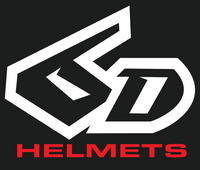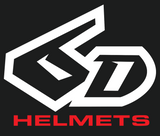6D ATR-3 Review - KEEFER, INC Testing
By: Kris Keefer
August 14, 2024
Read More HERE
It’s hard to write about something, that in some cases, can’t be FULLY tested until something goes wrong. In the world of helmet safety, we as buyers have to be very trustworthy customers. I mean…We have no choice but to be right? We have to trust in what the helmet company is telling us (about their latest safety technology offerings) is in fact the truth and works in real world conditions, just like the test results say back at the testing facility. Helmet tech is much like religion. You have to believe in what you’re reading and TRUST that is the correct information to put your faith in. I am very vocal about which helmet technology I trust, but I am not hear to preach on ALL of that today. As you know, I am fan/believer in 6D’s helmet technology and the people behind the helmet. The product is only good as the people behind it and I know the people at 6D are quality humans. Ok, so now that the intro is out of the way, let’s discuss 6D’s new ATR-3.
Introducing Generation Five of 6D’s Omni-Directional Suspension™ Technology. 6D’s most advanced system to date, designed for today’s extreme racing conditions. The enhanced system is more efficient, lighter, and freer to do its job, effectively mitigating energy transfer from crash impacts. Like its predecessor, the ATR-3 takes head protection to the next level with its groundbreaking concept of rebuild-ability. Unlike traditional helmets, which are typically discarded after a significant impact, the ATR-3 is designed to be rebuilt and reused, continuing the legacy of innovation started by the ATR-2.
A new feature that enhances airflow and comfort. With newly designed direct channels and improved flow, this system efficiently directs cool air to the brow area and throughout the helmet, ensuring optimal ventilation and temperature regulation during use. The multi-impact EPP outer liner is strategically positioned against the helmet shell’s inner surface. It is an exceptional energy absorption material designed with “Damping Towers” to provide a progressive spring rate to the suspended inner EPS liner during impacts. This capability, along with the EPP’s multi-impact feature, is key in allowing the ATR-3 to be rebuilt.
When putting on the ATR-3 you will notice two things real quick from the ATR-2. Weight feel on the head and ventilation. Both of these points have been improved dramatically. Let’s not leave out that it looks better/smaller than the ATR-2 as well. The ATR-2 looked big on your head in photos and the ATR-3 looks smaller on the rider. If you were on the fence about a 6D prior to the ATR-3, the less cumbersome look should make you much happier. Compared to other helmets (like the FLY Formula) the ATR-3 is still a little loud, but if you’re coming off of an ATR-2, you will notice the same amount of outside noise. The fit also feels a little more snug than the ATR-2 to me. I am a medium shell size and the ATR-3 medium I have does fit a little more snug near the cheeks, but 6D does offer smaller/bigger cheek pads to help with that. The top of the helmet feels/fits my head fine but the cheek pads do have a little thicker feel than in the past (however, I don’t know if the cheek pads itself are different, I would assume they are from looking at them). I would say if you’re a medium in the ATR-2 then a medium will work in the ATR-3 but you may need to break in the cheek pads a little (or simply go smaller). While I have been riding A LOT the past month or so, I have felt like the ATR-3 doesn’t fatigue my neck as much as the ATR-2, just like advertised. I have gone back to the ATR-2 a couple times to compare and the ATR-3 just feels less cumbersome on my head on longer test days. Ventilation is also a key benefit during the summer Southern California months and that is a welcomed feeling. I don’t know what it’s going to be like in the winter months so maybe get back to me on that. The field of vision (port of the helmet) is as good as the ATR-2 and does fit a wide range of goggles well. The ATR-3 does have a detachable roost/nose guard (unlike the ATR-2) that I like to keep in as this does help from getting unwanted roost inside the helmet. I would have thought I would like it removed but decided that the helmet deflects roost better with it as well as looks more attractive. Yes, I care about looks, so don’t shoot me.
Some Quick Points/Positives On Differences Between ATR2 and ATR3:
ODS 5
Still rebuildable
Improved safety technology, it’s not the drastic jump from the ATR 1 to the ATR 2 but a nice improvement overall.
More efficient overall safety system allows for a lighter helmet
Lower CG of helmet weight allows less neck/head fatigue while riding
Features Of ATR-3:
120g lighter than ATR 2 (1350g total)
Lower center of gravity, since the weight is really low on the helmet the rider feel is more significant.
Ventilation improvement- Direct brow vents, more direct channeling between the layers, dirt mitigation path to allow dirt stuck between the liners to escape.
Mud visor extension included
Magnetic chinstrap clasp instead of snap
Eject compatible
Speaker pockets
Drink tube loops on cheek pads
Overall, I am pleased with the function of the ATR-3 and if I am being honest, it’s tough for me to go back to the ATR-2 once I ride with the ATR-3 more and more. The price of the ATR-3 ranges from $759.95 for solid colors to $794.95 for graphic colorways. My favorite color ways come from the “NOVA” line as these are simple clean graphics that can go with a wide range of colors of gear sets. Listen to the RMATVMC Keefer Tested Podcast for the discount code, if you want to save a little dough on a new ATR-3. If you believe in safety for your head, in my opinion the ATR-3 is worth a look!






















